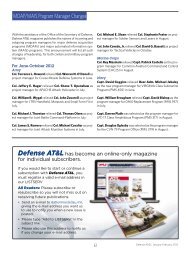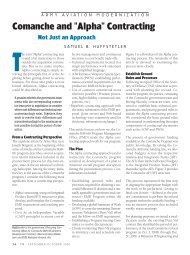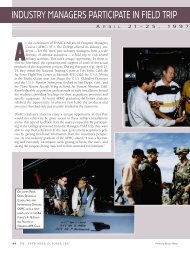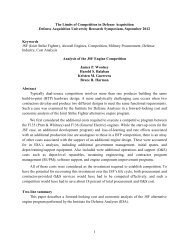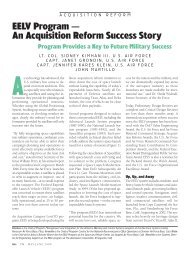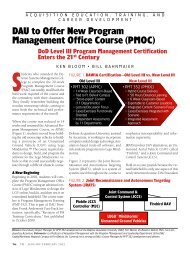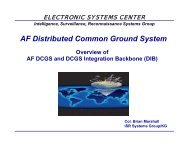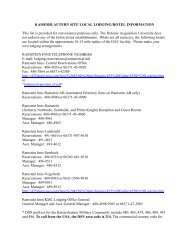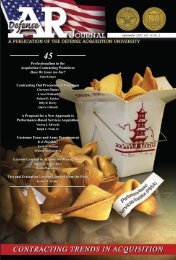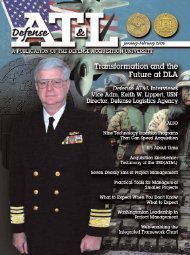Defense ARJ - Defense Acquisition University
Defense ARJ - Defense Acquisition University
Defense ARJ - Defense Acquisition University
You also want an ePaper? Increase the reach of your titles
YUMPU automatically turns print PDFs into web optimized ePapers that Google loves.
<strong>Defense</strong> <strong>Acquisition</strong> Review Journal<br />
systeM of systeMs enGineerinG: BeyonD aDaPtation of<br />
traDitional se<br />
Stakeholders in government and academia have begun to recognize fundamental<br />
differences between the disciplines of SE and SoSE. To develop and apply appropriate<br />
SoSE methodologies for the DoD, a System of Systems Engineering Center of<br />
Excellence (SoSECE) has been established under the auspices of the USD(AT&L).<br />
This organization has coordinated several SoSE conferences as has the Institute of<br />
Electrical and Electronics Engineers (IEEE). However, the distinctions between SE<br />
and SoSE are not yet widely appreciated. Experts at the National Center for Systems<br />
of Systems Engineering describe some of these differences in a seminal paper that<br />
characterizes SoSE maturity “in the embryonic stages of development” (Keating et<br />
al., 2003, p. 36). To frame a discussion of the dissimilarities between SE and SoSE,<br />
these authors consider eight significant areas of distinction: Focus, Objective, Approach,<br />
Expectation, Problem, Analysis, Goals, and Boundaries.<br />
Many of these differences apply directly to SoS acquisition in the DoD. Keating<br />
et al. (2003) argue that SoSE requires a fundamental shift in focus from the development<br />
of individual systems to the integration of multiple complex systems. Furthermore,<br />
Keating et al. describe the importance of methodology-based rather than<br />
process-based approaches for SoSE. While DoD has made significant progress in<br />
improving interoperability, current organizational structures are optimized for acquisition<br />
of single—albeit highly complex—systems through process-based approaches.<br />
Shifting cultural norms to reflect a focus and approach compatible with SoS development<br />
would suggest significant organizational adaptation.<br />
Similar changes will be required to efficiently budget for SoS development efforts.<br />
Keating et al. (2003) demonstrate the importance of flexible system boundaries<br />
and pluralistic system goals in SoSE. However, these principles contrast sharply with<br />
current practices and standards that segregate acquisition funds by solid boundaries<br />
and unitary program goals. Thus, adapting the PPBE system to cope with these SoS<br />
characteristics will become increasingly important.<br />
Generating appropriate requirements for an SoS will also require a different<br />
approach. The JCIDS operates most effectively when problems are clearly defined,<br />
expected capabilities are linked to system characteristics, and overarching objectives<br />
can be met by optimizing performance within cost and schedule guidelines. SE<br />
provides an ideal analytical framework for this JCIDS construct. In contrast, effective<br />
SoS development requires a radically different requirements paradigm that describes<br />
182<br />
Decisions intended to alleviate one problem often carry<br />
unintended consequences that aggravate others.



